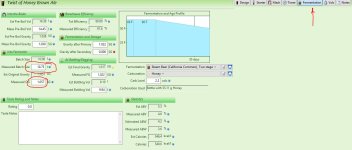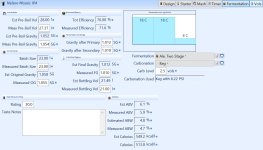Hi
Sorry, but I can't seem to find a help/explanation for the vols tab. What I'd like to know is how it is set up to be used, particularly when adding top up. Is this for adding it pre-fermentation? If so, how does it relate to the fermentation tab (what volume and gravity should I put into the 'into fermenter' section)? Is it possible to enter the measured post-boil volume (on the vols tab) to allow comparison to predicted and therefore make the equipment adjustments? Is the batch size (quick tip says 'estimated batch size of the recipe, into the fermenter') from the target volume in the design? Why does the estimated bottling volume seem to use this number rather than the measured batch size? What number is the measured batch size supposed to be (measured pre top up or post)?
Sorry for all the questions! If there is a video or something that explains how these numbers all relate to each other, can you please point me to the link? Otherwise, I am using a separate excel spreadsheet to work all this out - but I suspect that BS2 actually does do it all, more accurately and powerfully than what I am doing at the moment. The issue is probably with the user (read: me) and once I understand it, I'll be able to make better use of it.
Overall - fantastic program by the way!!!
Sorry, but I can't seem to find a help/explanation for the vols tab. What I'd like to know is how it is set up to be used, particularly when adding top up. Is this for adding it pre-fermentation? If so, how does it relate to the fermentation tab (what volume and gravity should I put into the 'into fermenter' section)? Is it possible to enter the measured post-boil volume (on the vols tab) to allow comparison to predicted and therefore make the equipment adjustments? Is the batch size (quick tip says 'estimated batch size of the recipe, into the fermenter') from the target volume in the design? Why does the estimated bottling volume seem to use this number rather than the measured batch size? What number is the measured batch size supposed to be (measured pre top up or post)?
Sorry for all the questions! If there is a video or something that explains how these numbers all relate to each other, can you please point me to the link? Otherwise, I am using a separate excel spreadsheet to work all this out - but I suspect that BS2 actually does do it all, more accurately and powerfully than what I am doing at the moment. The issue is probably with the user (read: me) and once I understand it, I'll be able to make better use of it.
Overall - fantastic program by the way!!!



